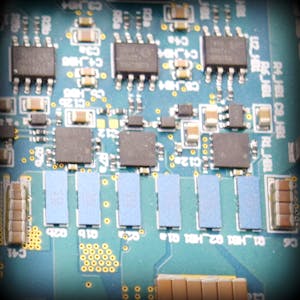Bridging Theory and Practice — Simulating Power Electronic Circuits with Python
Introduction
Power electronics plays a crucial role in modern energy systems — from battery chargers and DC–DC converters to motor drives and renewable energy inverters. However, simulating these circuits can be challenging because they are non-linear, time-varying, and involve switching elements.
Most commercial simulation tools like MATLAB/Simulink, PSIM, or PLECS are powerful but expensive and often hide the underlying numerical modeling from the user. That’s where the Udemy course “Simulating Power Electronic Circuits using Python – A Beginner’s Guide to Simulations with Theory and Example” stands out.
This course takes a practical, open-source approach by teaching how to simulate power electronic circuits in Python — from first principles — combining theoretical understanding with hands-on coding.
Course Overview and Structure
The course introduces learners to the simulation of power electronic circuits using Python Power Electronics, a free and open-source simulation framework. It is designed for students, educators, and engineers who want to understand how simulation works rather than simply running a ready-made tool.
What the course covers:
-
Fundamentals of circuit theory and dynamic equations
-
Setting up a Python-based simulation environment
-
Simulating linear circuits (R, RC, RL, RLC)
-
Modeling non-linear devices such as diodes and switches
-
Implementing switching logic and PWM control
-
Simulating DC–DC converters such as buck and boost converters
-
Plotting and analyzing voltage and current waveforms
The course is structured to progress from basic to complex circuits, allowing learners to develop both theoretical understanding and practical simulation skills.
Who Should Take This Course
This course is ideal for:
-
Electrical and Electronics Engineering students who want to visualize and experiment with circuit behavior.
-
Working engineers or researchers looking for cost-effective simulation tools.
-
Python enthusiasts interested in applying their coding skills to real-world electrical systems.
-
Educators who want to integrate open-source simulation into their teaching.
It is not ideal for:
-
Absolute beginners in both electronics and programming.
-
Learners expecting ready-made solutions without coding involvement.
-
Professionals seeking advanced power electronic system modeling with EMI, parasitic, or thermal effects.
Learning Approach
The course follows a theory + simulation approach — each concept is first explained using circuit fundamentals, followed by implementation in Python.
Key aspects of the teaching style include:
-
Code-along format – You build each simulation step by step with the instructor.
-
Hands-on examples – Every concept is reinforced with a working example.
-
Practical visualization – You generate and interpret waveforms for current, voltage, and switching states.
-
Incremental complexity – Starting from resistive circuits, the course moves toward converters and control logic.
This method ensures that learners not only use Python but also understand how the equations of motion for power circuits are solved numerically.
Key Takeaways from the Course
1. Understanding Circuit Dynamics
You’ll learn to write differential equations representing RLC circuits, model energy storage components, and understand transient and steady-state behavior.
2. Working with Nonlinear Components
The course demonstrates how to simulate diodes and transistors using conditional statements and switching logic.
3. Implementing Switching and Control
You’ll write Python code to simulate pulse-width modulation (PWM) and observe its effect on converter output voltage.
4. Building DC–DC Converter Models
From the buck to the boost converter, you’ll simulate key topologies, analyze current and voltage ripples, and study the effect of duty cycle and component values.
5. Visualization and Analysis
Using matplotlib, you’ll learn to plot simulation results and interpret waveforms — a critical skill for debugging and understanding circuit operation.
Advantages of Learning Simulation in Python
-
Open Source and Free – No licenses required; everything runs on Python.
-
Cross-Platform – Works on Windows, macOS, and Linux.
-
Deep Understanding – You see how mathematical models translate into numerical simulations.
-
Extensible – You can modify or extend the code for your own projects.
-
Integration-Friendly – Easily combine with control algorithms, data analysis, or machine learning models.
This approach turns Python into both a learning laboratory and a research platform for power electronics.
Challenges and How to Overcome Them
-
Initial Setup Issues – Installing Python libraries and configuring the simulator can take time. Following the course setup guide carefully resolves most issues.
-
Learning Curve for Non-Coders – If you’re new to programming, start with simple Python syntax exercises before tackling circuit simulations.
-
Choosing Time Steps and Solvers – Numerical accuracy depends on proper selection of time steps (
dt) and integration methods. The course explains how to avoid instability. -
Limited Topology Range – The course focuses on fundamental circuits, but once you master them, extending to complex ones is straightforward.
Tips for Success
-
Recreate each simulation yourself — don’t just watch.
-
Experiment with different component values and switching frequencies.
-
Document your findings with plots and notes.
-
Review basic circuit theory alongside the code.
-
Challenge yourself to modify a given converter or create a new one.
Why This Course Stands Out
What makes this course unique is its hands-on, transparent approach. Rather than relying on a prebuilt simulator, it teaches the mechanics of simulation — how numerical solvers step through the equations that describe circuit behavior.
You’re not just using Python; you’re building your own simulation engine. This gives you a strong foundation to later use or even develop advanced tools for converter design, digital control, and system optimization.
Conclusion
Simulating Power Electronic Circuits using Python – A Beginner’s Guide to Simulations with Theory and Example bridges the gap between theoretical circuit analysis and practical simulation. It empowers learners to understand, model, and visualize complex converter behaviors using free, open-source tools.
For anyone passionate about power electronics, simulation, and Python, this course is an excellent starting point. You’ll finish it with not only a deeper understanding of circuits but also a set of Python scripts you can adapt, expand, and use in real-world design or research.
If you’ve ever wanted to truly see your circuits come alive through simulation — this course is your gateway.

























No comments